Birdfinding.info ⇒ Common on Guadeloupe, especially in Guadeloupe National Park (e.g., at Cascade aux Ecrevisses and Corossol), and Dominica, where it can be found at all of the frequently visited sites. Also fairly common on St. Kitts (e.g., Romney Manor) and in the Centre Hills of Montserrat. On St. Vincent it can be found reliably along the Vermont Nature Trail. Less often reported from Saba, Nevis, St. Eustatius, Marie-Gallante, and the Grenadines.
Brown Trembler
Cinclocerthia ruficauda
Endemic to the Lesser Antilles: from Saba south to Dominica, and separately on St. Vincent and the Grenadines (Bequia, Union, and possibly others). Occurs in wet and dry forests, open woodlands, and gardens.
It may also occur on Grenada, although its presence there appears to be undocumented in recent decades, and is known from fossilized remains on Antigua. There are, in addition, reports from both Martinique and St. Lucia, although most reports on these islands date back to when it was considered conspecific with Gray Trembler and none is considered certain.
Identification
An aberrant thrasher with largely rufous-brown plumage, an exceptionally large bill, a flat, grayish head, blackish mask, plump body, and vivid yellow eyes.
Tremblers are named for a distinctive behavior in which they lower their wings, tremble, and wag their tails.
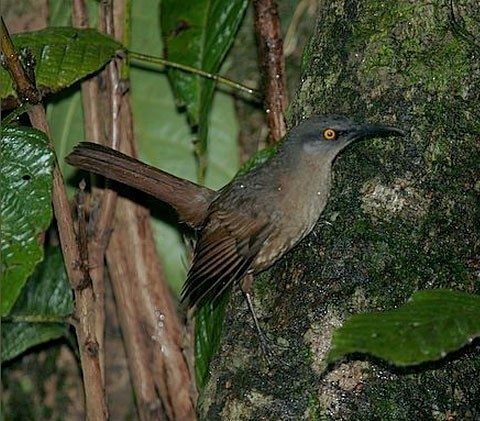
Brown Trembler, C. r. tremula. (Guadeloupe; December 7, 2004.) © Gerard R. Dewaghe
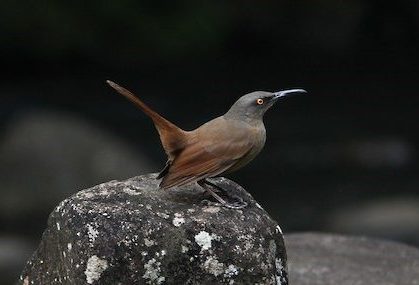
Brown Trembler, C. r. tremula. (Guadeloupe Zoo, Guadeloupe; February 27 2019.) © Harold Forsyth
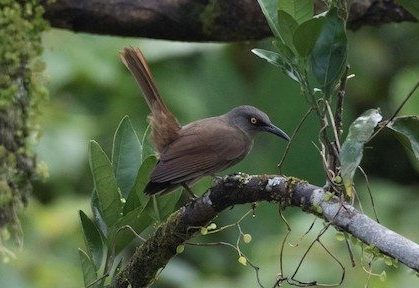
Brown Trembler, C. r. ruficauda. (Morne Diablotin National Park, Dominica; March 3, 2018.) © Brian Sullivan
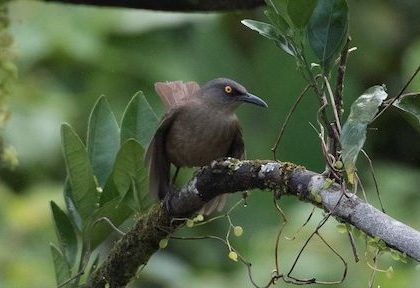
Brown Trembler, C. r. ruficauda. (Morne Diablotin National Park, Dominica; March 3, 2018.) © Brian Sullivan

Brown Trembler, C. r. tremula. (Cascade aux Ecrevisses, Guadeloupe; November 18, 2014.) © Charles Gates
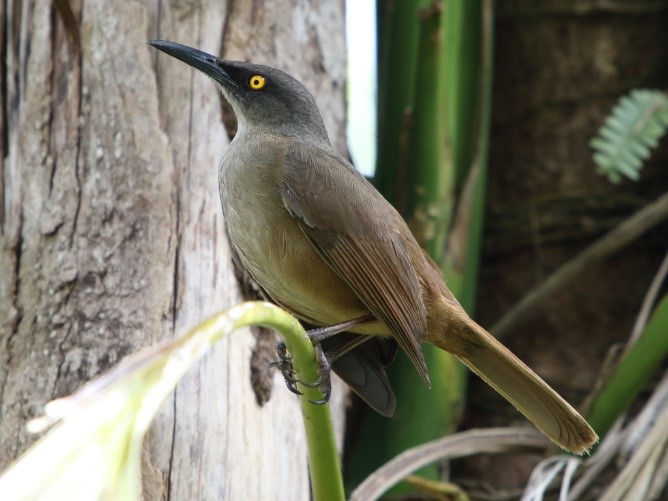
Brown Trembler, C. r. ruficauda. (St. David, Dominica; March 22, 2018.) © Colin D. Jones

Brown Trembler, C. r. pavida. (St. Kitts; January 26, 2018.) © Scott Krammer

Brown Trembler, C. r. tremula. (Maison de la Forêt, Guadeloupe; January 15, 2019.) © Thomas Monjoin
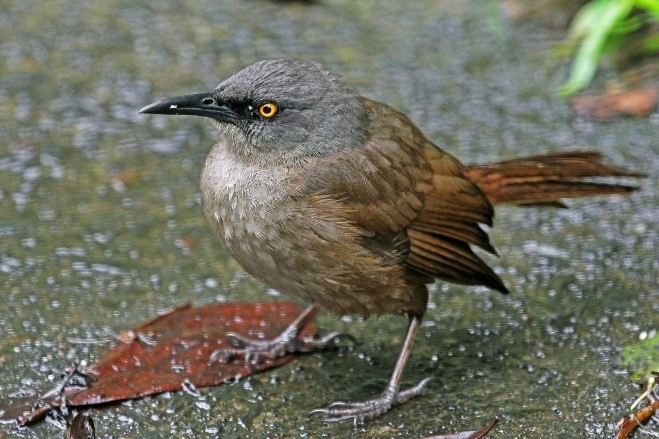
Brown Trembler, C. r. tremula. (Cascade aux Ecrevisses, Guadeloupe; April 8, 2013.) © Greg Griffith

Brown Trembler, C. r. tremula. (Corossol, Guadeloupe; October 17, 2018.) © Peter Kaestner

Brown Trembler, C. r. tremula. (Basse-Terre, Guadeloupe; November 15, 2013.) © Nick Smith

Brown Trembler, C. r. pavida. (Romney Manor, St. Kitts; March 11, 2018.) © Steven Mlodinow
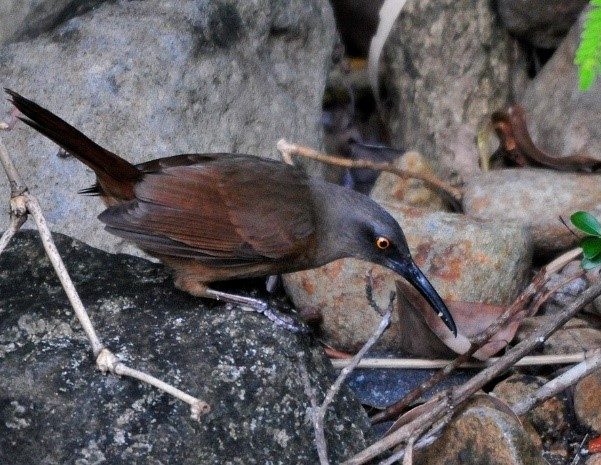
Brown Trembler, C. r. tremula. (Pointe-Noire, Guadeloupe; January 15, 2014.) © BAUDRY

Brown Trembler, C. r. tremula, an exceedingly rusty individual. (Basse-Terre, Guadeloupe; November 15, 2013.) © Nick Smith

Brown Trembler, C. r. tremula, an exceedingly rusty individual. (Corossol, Guadeloupe; December 14, 2018.) © Hannes Leonard
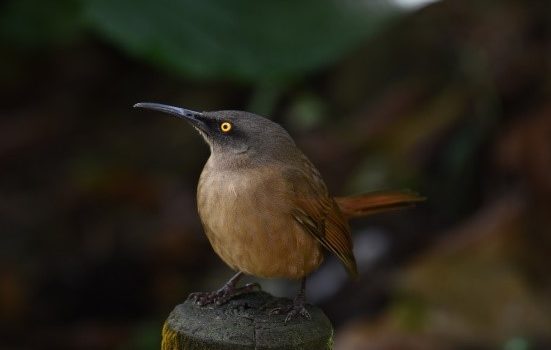
Brown Trembler, C. r. tremula. (Corossol, Guadeloupe; December 14, 2018.) © Hannes Leonard

Brown Trembler, C. r. pavida. (Romney Manor, St. Kitts; March 4, 2018.) © Steven Mlodinow
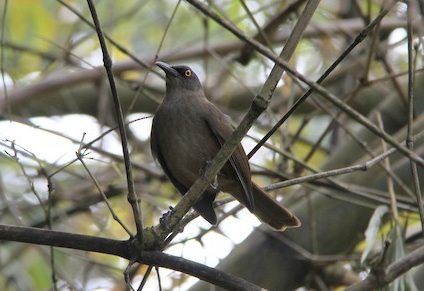
Brown Trembler, C. r. tremula, a sooty-brown individual. (Jardin Botanique de Deshaies, Guadeloupe; February 15, 2019.) © Harold Forsyth

Brown Trembler, C. r. tremula. (Cascade aux Ecrevisses, Guadeloupe; March 4, 2018.) © Brian Sullivan
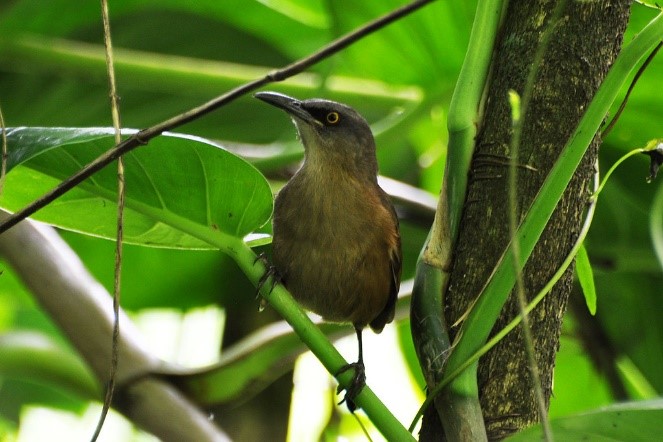
Brown Trembler, C. r. ruficauda. (Roseau, Dominica; November 8, 2011.) © Don Faulkner
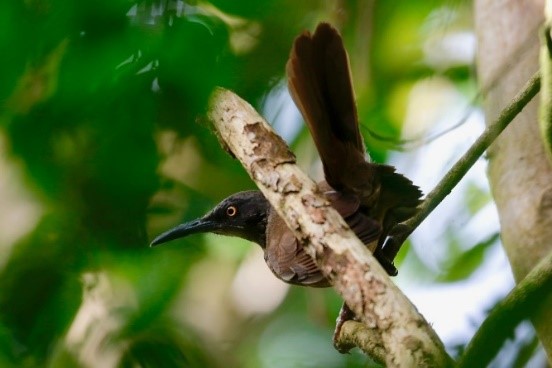
Brown Trembler, C. r. pavida. (Centre Hills, Montserrat; April 14, 2018.) © Bird Explorers
Voice. Vocalizations are richly varied. One typical song is a jumble of whistled notes, many of which are soft, high-pitched, and sibilant:
Sometimes sings in multiple “voices,” some notes high and thin, and others much deeper and sharper: Macauley Library recording from Dominica. © Linda Macauley
Also brief warbled trills: Macauley Library recording from Montserrat. © Mark Oberle
And clear whistled notes: Macauley Library recording from Vermont Nature Trail on St. Vincent. © Linda Macauley
Notes
Polytypic species consisting of four (or three) recognized subspecies. Traditionally considered conspecific with Gray Trembler, collectively the Trembler (C. ruficauda), but since 1989 the consensus has been that they are separate, and genetic analyses have supported this conclusion.
Frontiers of Taxonomy: Northern and Southern Brown Tremblers. The subspecies of Brown Trembler that occupy the islands from Saba to Guadeloupe (pavida and tremula) reportedly average larger than the southern subspecies, and have been proposed as a separate species or distinct form: “Northern Brown Trembler” (C. tremula), in which case the nominate and southernmost subspecies (ruficauda and tenebrosa) would become the “Southern Brown Trembler” (C. ruficauda). This may ultimately prove to be justified, but the degree of variability among and within subspecies does not appear to be well understood, and the vocalizations reportedly do not differ noticeably.
References
Brewer, D., and B.K. MacKay. 2001. Wrens, Dippers, and Thrashers. Yale University Press. New Haven.
Cody, M. 2019. Brown Trembler (Cinclocerthia ruficauda). In Handbook of the Birds of the World Alive (J. del Hoyo, A. Elliott, J. Sargatal, D.A. Christie, and E. de Juana, eds.). Lynx Edicions, Barcelona. https://www.hbw.com/node/58181. (Accessed November 23, 2019.)
eBird. 2019. eBird: An online database of bird distribution and abundance. Cornell Lab of Ornithology, Ithaca, N.Y. http://www.ebird.org. (Accessed November 23, 2019.)
Raffaele, H., J. Wiley, O. Garrido, A. Keith, and J. Raffaele. 1998. A Guide to the Birds of the West Indies. Princeton University Press, Princeton, N.J.
Sibbald, E. 2014. Brown Trembler (Cinclocerthia ruficauda), version 1.0. In Neotropical Birds Online (T.S. Schulenberg, ed.). Cornell Lab of Ornithology, Ithaca, N.Y. https://doi.org/10.2173/nb.brotre1.01.
